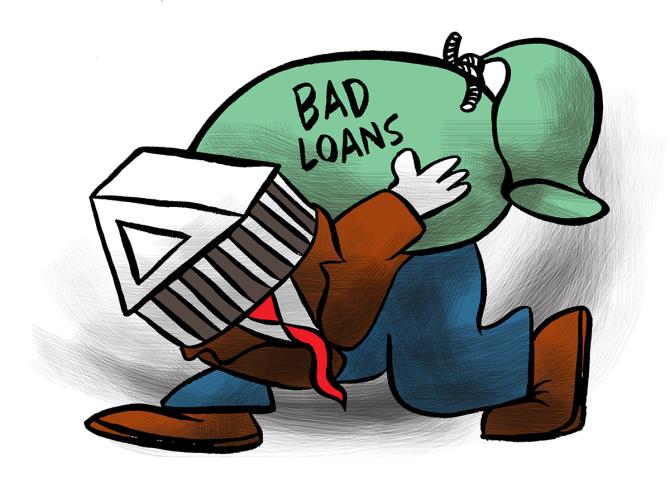Why do we need a bad bank, owned by the banks themselves when there are at least 28 ARCs around, asks Tamal Bandyopadhyay.

The headache over recovery of bad loans will be less for bankers now.
The Budget says there will be an asset reconstruction company (ARC) and an asset management company (AMC) to consolidate and take over their large bad loans, manage them and sell them to alternative investment funds and other investors.
Why do we create a moral hazard by allowing the banks themselves to own a bad bank when there are at least 28 ARCs around? (One more, to be floated by Yes Bank Ltd, is awaiting the regulatory nod.) Except for a few owned by strong investors, most dont have enough capital to buy such loans.
The insolvency law has been slow in the recovery of bad loans for many reasons.
Under this law, any default of at least Rs 100,000 could be dealt at the National Company Law Tribunal (NCLT), a quasi-judicial body that adjudicates issues relating to Indian companies. (The threshold was raised to Rs 1 crore (Rs 10 million) in March 2020 to keep small and medium enterprises out of the insolvency process during the COVID-19 period.)
Close to 11,000 cases were pending with the NCLT for initiation of insolvency resolution when the government announced a six-month holiday in June 2020 on the filing of fresh cases in Covid time. This has been extended till March 25, 2021.
Typically, after a case is filed, it takes between a fortnight and a month to be admitted to the NCLT.
The platform should find a solution within 180 days; but it can take another 90 days, depending on the complexity of a case.
The 270-day timeline, however, doesn’t include the time spent on litigation, which is often long.
The Act was amended in August 2019 to ensure completion within 330 days from when a case is admitted but, in practice, if it takes longer due to litigation, courts are likely to accept such a delay instead of passing a liquidation order.
Even the losers can make fresh bids and new bidders can join the fray. The law has been amended to prevent any fresh bids after a deadline but it can get extended for all bidders to put up better bids.
Besides, the defaulters can always move to the appellate body, high courts and even the Supreme Court.
In the process, the value of many projects gets destroyed. Most bids, at the NCLT-driven process, are close to the liquidation value of the projects, far lower than their enterprise value.
The big bad bank will solve this problem. Or, so is the idea.
How will it work? The public sector banks will chip in with equity with their private peers sharing a part.
To kick it off, large bad loans of Rs 500 crore or more each -- overall around Rs 2.25 trillion -- will be transferred to the ARC at the so-called net book value, after adjusting the provision done in sync with Reserve Bank of India norms.
In the absence of bidding, there won't be any price discovery for the bad loans. This is why certain legal changes are required in the run up to the creation of the ARC.
At net book value, bad loans anywhere between Rs 50,000 crore (Rs 500 billion) and Rs 75,000 crore (Rs 750 billion) will be transferred from the banks' books to the ARC, which will offer 15 per cent cash and 85 per cent security receipts (SRs) to the banks.
As SRs are banks investments, the bad loans sold to the ARC will shift from the banks' asset book to the investment book.
Once the recovery is complete, the SRs will be redeemed. Any upside -- recovery higher than the price at which the loans were transferred -- will be passed on to the banks as they own the ARC.
In case of lower recovery, the banks will get less money.
If a thermal power project or a road project or an airport, which hadnt been able to service loan, needs time to come into its own or an infusion of small money, the AMC will ensure that.
Along with the banking sector, which will be able to realise the enterprise value of such exposures, the real economy will also get the benefit of this.
Also, if the ARC can attract murky alternative investment funds as buyers, the secondary market for the SRs will be created, giving a boost to the recovery process.
An AMC doesn't need much capital but an ARC does. Otherwise, how will it be able to buy the bad loans (paying 15 per cent cash)? For buying Rs 75,000 crore of bad loans, it will need Rs 11,250 crore.
Where will the money come from? Will the banks chip in? Then, how will it be a cash-neutral transaction, as media reports suggest?
While the sale of bad loans will be fast as there is a formula for pricing (net book value), and lack of consensus among banks on how much haircut they can take for selling bad loans will not come on the way, many questions remain.
For instance, will there be special RBI dispensation excusing this ARC from regulations applicable to the existing ones? If yes, shouldn't the current regulations applicable to other ARCs be reviewed to create a level playing field?
Will the existing ARCs have to focus only on small loans (less than Rs 500 crore) from now on?
Will the bad bank have a sunset clause?
The RBI allows eight years for resolution of an acquired asset. After this, it has to be written off both by the seller bank and the ARC, but the recovery efforts can continue with the SR-holder's permission. Should the timeline be changed?
Will there be any forbearance to exempt the sale of bad loans to the ARC from the glare of the investigative agencies and the national auditor -- something that has adversely affected banks' sale of bad assets?
Finally, who will run the show? Retired public sector bankers and bureaucrats?
Infra DFI
While the bad bank will help clean up the pile of bad loans, the creation of a development finance institution (DFI) for infrastructure financing should whet the banks' appetite for lending.
Indeed, a DFI can be a catalyst for long-term project financing, but where will it get the money to lend? In the late 1990s, the old DFIs had to be buried after the government closed the tap for cheap money, trapping them in huge asset-liability mismatches.
Media reports, quoting finance ministry officials, suggest India Infrastructure Finance Company Ltd (IIFCL) will be subsumed into the proposed DFI.
The government infused Rs 5,300 crore (Rs 53 billion) equity through a recapitalisation bond after investing Rs 500 crore in May, raising IIFCL's capital close to Rs 10,000 crore (Rs 100 billion).
Another Rs 10,000 crore capital will be added, giving a Rs 20,000 crore (Rs 200 billion) capital cushion to the new DFI.
This is fine. But the cat comes out of the bag when the plan envisages cleaning up Rs 4,500 crore (Rs 45 billion) of IIFCL's bad loan first.
Is it a rescue plan for IIFCL which, in 15 years (till December 2020), has sanctioned Rs 95,176 crore (Rs 951.76 billion) to 510 projects and disbursed Rs 43,313 cror (Rs 433.13 billion)e? The proposed DFI plans Rs 5 trillion lending in the next three years. Neither the quality of wine nor the shape of the new bottle seem to be exciting.
Even if it is run by professionals with accountability, where will the money come from? Is the idea behind the new DFI to create a credit enhancement institution?
Tamal Bandyopadhyay is a consulting editor with Business Standard, is an author and senior adviser to Jana Small Finance Bank Ltd.
Feature Presentation: Rajesh Alva/Rediff.com











